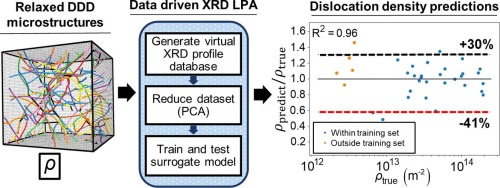当前位置:
X-MOL 学术
›
Comp. Mater. Sci.
›
论文详情
Our official English website, www.x-mol.net, welcomes your
feedback! (Note: you will need to create a separate account there.)
Virtual diffraction analysis of dislocations and dislocation networks in discrete dislocation dynamics simulations
Computational Materials Science ( IF 3.1 ) Pub Date : 2020-03-01 , DOI: 10.1016/j.commatsci.2019.109473 Darshan Bamney , Aaron Tallman , Laurent Capolungo , Douglas E. Spearot
Computational Materials Science ( IF 3.1 ) Pub Date : 2020-03-01 , DOI: 10.1016/j.commatsci.2019.109473 Darshan Bamney , Aaron Tallman , Laurent Capolungo , Douglas E. Spearot

|
Abstract This work proposes a data-analytics-based method to correlate diffraction peak broadening to dislocation density in relaxed dislocation networks. The model relies on two key developments: the generation of virtual diffraction signatures of dislocated crystals and the development of a surrogate model to predict dislocation density from diffraction profiles. First, two algorithms are introduced for the generation of diffraction profiles from discrete dislocation dynamics (DDD) simulations. Both algorithms leverage the full-field spectral computation of the elastic strain fields generated in the presence of dislocations. However, the two algorithms differ in their treatment of correlations in the elastic strain field; the impact of this difference on the shape of diffraction peaks is emphasized. A database containing 220 virtual diffraction profiles is generated from networks of dislocations in Al using the correlation-dependent algorithm. This dataset is employed to train and test a surrogate model. Predictions consistently yield dislocation densities within a 90% confidence interval of +30% to −41%, which is an improvement over prior dislocation density prediction methods. It is thus demonstrated that the simultaneous use of virtual diffraction and data analytics can yield alternative models for the analysis of diffraction line profiles in which uncertainty can be quantified for complex dislocation networks.
中文翻译:

离散位错动力学模拟中位错和位错网络的虚拟衍射分析
摘要 这项工作提出了一种基于数据分析的方法,将衍射峰展宽与松弛位错网络中的位错密度相关联。该模型依赖于两个关键的发展:位错晶体的虚拟衍射特征的产生和替代模型的发展,以根据衍射剖面预测位错密度。首先,引入了两种算法来从离散位错动力学 (DDD) 模拟中生成衍射轮廓。这两种算法都利用了在位错存在时产生的弹性应变场的全场谱计算。然而,这两种算法在处理弹性应变场中的相关性方面有所不同。强调了这种差异对衍射峰形状的影响。包含 220 个虚拟衍射轮廓的数据库是使用相关依赖算法从 Al 中的位错网络生成的。该数据集用于训练和测试代理模型。预测始终在 +30% 至 -41% 的 90% 置信区间内产生位错密度,这是对先前位错密度预测方法的改进。因此证明,同时使用虚拟衍射和数据分析可以产生用于分析衍射线轮廓的替代模型,其中可以量化复杂位错网络的不确定性。预测始终在 +30% 至 -41% 的 90% 置信区间内产生位错密度,这是对先前位错密度预测方法的改进。因此证明,同时使用虚拟衍射和数据分析可以产生用于分析衍射线轮廓的替代模型,其中可以量化复杂位错网络的不确定性。预测始终在 +30% 至 -41% 的 90% 置信区间内产生位错密度,这是对先前位错密度预测方法的改进。因此证明,同时使用虚拟衍射和数据分析可以产生用于分析衍射线轮廓的替代模型,其中可以量化复杂位错网络的不确定性。
更新日期:2020-03-01
中文翻译:

离散位错动力学模拟中位错和位错网络的虚拟衍射分析
摘要 这项工作提出了一种基于数据分析的方法,将衍射峰展宽与松弛位错网络中的位错密度相关联。该模型依赖于两个关键的发展:位错晶体的虚拟衍射特征的产生和替代模型的发展,以根据衍射剖面预测位错密度。首先,引入了两种算法来从离散位错动力学 (DDD) 模拟中生成衍射轮廓。这两种算法都利用了在位错存在时产生的弹性应变场的全场谱计算。然而,这两种算法在处理弹性应变场中的相关性方面有所不同。强调了这种差异对衍射峰形状的影响。包含 220 个虚拟衍射轮廓的数据库是使用相关依赖算法从 Al 中的位错网络生成的。该数据集用于训练和测试代理模型。预测始终在 +30% 至 -41% 的 90% 置信区间内产生位错密度,这是对先前位错密度预测方法的改进。因此证明,同时使用虚拟衍射和数据分析可以产生用于分析衍射线轮廓的替代模型,其中可以量化复杂位错网络的不确定性。预测始终在 +30% 至 -41% 的 90% 置信区间内产生位错密度,这是对先前位错密度预测方法的改进。因此证明,同时使用虚拟衍射和数据分析可以产生用于分析衍射线轮廓的替代模型,其中可以量化复杂位错网络的不确定性。预测始终在 +30% 至 -41% 的 90% 置信区间内产生位错密度,这是对先前位错密度预测方法的改进。因此证明,同时使用虚拟衍射和数据分析可以产生用于分析衍射线轮廓的替代模型,其中可以量化复杂位错网络的不确定性。











































 京公网安备 11010802027423号
京公网安备 11010802027423号